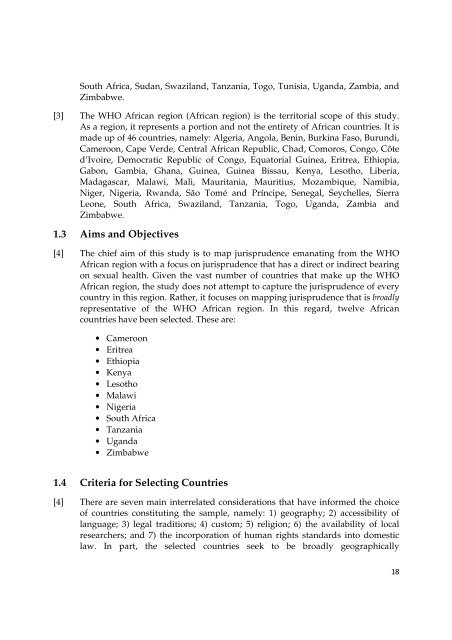sexual health and human rights in the african region - The ICHRP
sexual health and human rights in the african region - The ICHRP
sexual health and human rights in the african region - The ICHRP
Create successful ePaper yourself
Turn your PDF publications into a flip-book with our unique Google optimized e-Paper software.
South Africa, Sudan, Swazil<strong>and</strong>, Tanzania, Togo, Tunisia, Ug<strong>and</strong>a, Zambia, <strong>and</strong><br />
Zimbabwe.<br />
[3] <strong>The</strong> WHO African <strong>region</strong> (African <strong>region</strong>) is <strong>the</strong> territorial scope of this study.<br />
As a <strong>region</strong>, it represents a portion <strong>and</strong> not <strong>the</strong> entirety of African countries. It is<br />
made up of 46 countries, namely: Algeria, Angola, Ben<strong>in</strong>, Burk<strong>in</strong>a Faso, Burundi,<br />
Cameroon, Cape Verde, Central African Republic, Chad, Comoros, Congo, Côte<br />
d’Ivoire, Democratic Republic of Congo, Equatorial Gu<strong>in</strong>ea, Eritrea, Ethiopia,<br />
Gabon, Gambia, Ghana, Gu<strong>in</strong>ea, Gu<strong>in</strong>ea Bissau, Kenya, Lesotho, Liberia,<br />
Madagascar, Malawi, Mali, Mauritania, Mauritius, Mozambique, Namibia,<br />
Niger, Nigeria, Rw<strong>and</strong>a, São Tomé <strong>and</strong> Príncipe, Senegal, Seychelles, Sierra<br />
Leone, South Africa, Swazil<strong>and</strong>, Tanzania, Togo, Ug<strong>and</strong>a, Zambia <strong>and</strong><br />
Zimbabwe.<br />
1.3 Aims <strong>and</strong> Objectives<br />
[4] <strong>The</strong> chief aim of this study is to map jurisprudence emanat<strong>in</strong>g from <strong>the</strong> WHO<br />
African <strong>region</strong> with a focus on jurisprudence that has a direct or <strong>in</strong>direct bear<strong>in</strong>g<br />
on <strong>sexual</strong> <strong>health</strong>. Given <strong>the</strong> vast number of countries that make up <strong>the</strong> WHO<br />
African <strong>region</strong>, <strong>the</strong> study does not attempt to capture <strong>the</strong> jurisprudence of every<br />
country <strong>in</strong> this <strong>region</strong>. Ra<strong>the</strong>r, it focuses on mapp<strong>in</strong>g jurisprudence that is broadly<br />
representative of <strong>the</strong> WHO African <strong>region</strong>. In this regard, twelve African<br />
countries have been selected. <strong>The</strong>se are:<br />
• Cameroon<br />
• Eritrea<br />
• Ethiopia<br />
• Kenya<br />
• Lesotho<br />
• Malawi<br />
• Nigeria<br />
• South Africa<br />
• Tanzania<br />
• Ug<strong>and</strong>a<br />
• Zimbabwe<br />
1.4 Criteria for Select<strong>in</strong>g Countries<br />
[4] <strong>The</strong>re are seven ma<strong>in</strong> <strong>in</strong>terrelated considerations that have <strong>in</strong>formed <strong>the</strong> choice<br />
of countries constitut<strong>in</strong>g <strong>the</strong> sample, namely: 1) geography; 2) accessibility of<br />
language; 3) legal traditions; 4) custom; 5) religion; 6) <strong>the</strong> availability of local<br />
researchers; <strong>and</strong> 7) <strong>the</strong> <strong>in</strong>corporation of <strong>human</strong> <strong>rights</strong> st<strong>and</strong>ards <strong>in</strong>to domestic<br />
law. In part, <strong>the</strong> selected countries seek to be broadly geographically<br />
18
















